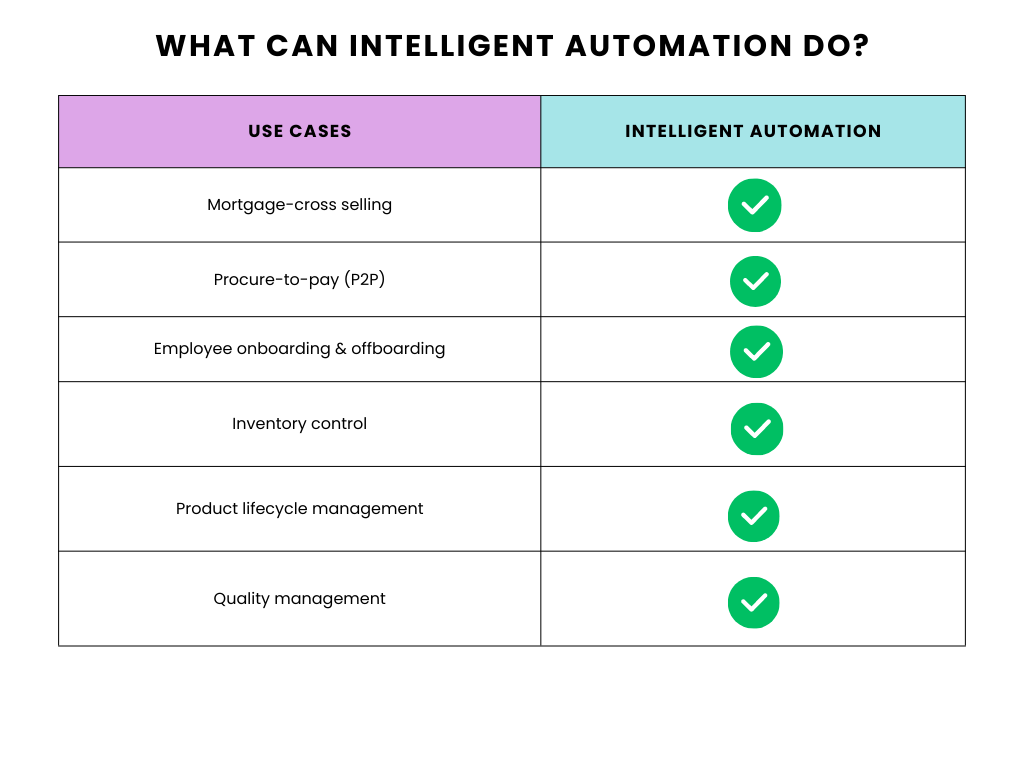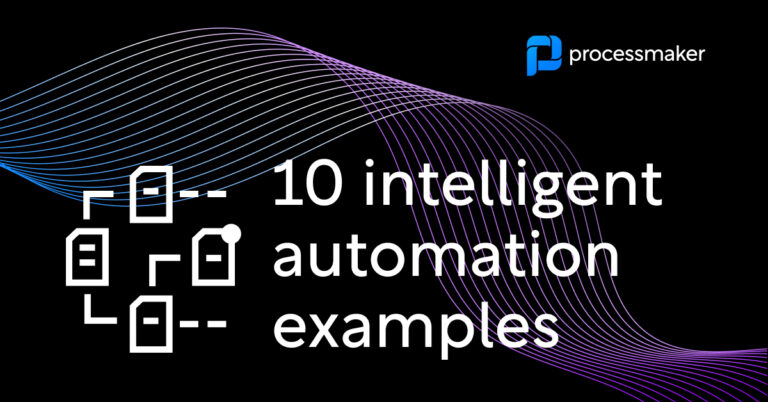More organizations are turning to intelligent automation to increase efficiency, boost hyperproductivity, and reduce costs. And why shouldn’t they?
With the combination of a full platform of BPA, IDP, and process management applications, AI truly unlocks a democratization of the tool and enables hyperproductivity.
Intelligent automation has a broad range of potential use cases. It’s rapidly grown in popularity, becoming a major differentiator for process automation. Let’s look at 10 intelligent automation examples that can help transform your organization.
But first, what is intelligent automation?
Intelligent automation is a transformative technology that combines the power of artificial intelligence (AI) with automation to revolutionize business processes. By leveraging AI, organizations can automate repetitive tasks, streamline workflows, and enhance decision-making capabilities.
This powerful combination allows businesses to handle complex tasks with greater efficiency and accuracy. Whether it’s document processing, customer service, or financial transactions, intelligent automation can significantly improve productivity and operational efficiency. By automating mundane tasks, employees are freed up to focus on more strategic and creative work, driving innovation and growth within the organization.
Benefits of intelligent automation
The benefits of intelligent automation are manifold, making it a game-changer for modern businesses:
- Enhanced productivity: By automating routine tasks, teams can shift their focus towards more strategic initiatives that foster growth and innovation.
- Improved accuracy: Automation reduces the possibility of human error, ensuring more consistent and reliable outcomes.
- Scalability: Businesses can seamlessly expand operations without proportionate increases in costs or resources, allowing for greater flexibility in meeting market demands.
- Cost reduction: Operational costs decrease as efficiency rises, freeing up capital to invest in other areas of the business.
- Increased agility: Organizations become more agile, capable of adapting quickly to changing market conditions and leveraging new opportunities as they arise.
These benefits collectively transform the way enterprises operate, setting a new standard of excellence and unleashing untapped potential.
10 examples of intelligent automation use
Now let’s get straight to the top examples of using intelligent automation to drive excellence in business operations.
1. Mortgage cross-selling
The mortgage lending market is highly competitive. Despite this challenge, most banks have overlooked perhaps their greatest asset – their existing customers. In fact, only 20% of customers obtain a mortgage from their primary bank.
For these reasons, more and more banks are turning to intelligent automation to cross-sell mortgages to existing customers. Intelligent automation platforms leverage large amounts of customer data to identify cross-selling opportunities. For example, the system can notify bankers when customers exhibit certain behaviors indicative of home buying.
What’s relevant behavior? A relevant behavior could include something that suggests a change in job status (i.e., new source of deposits). Once notified, bankers can reach out to customers using the most effective means of communication according to their data profiles.
2. Procure-to-pay (P2P)
Ever thought about how repetitive and time-consuming traditional procure-to-pay (P2P) processes are? We certainly have. Typical P2P tasks include things like vendor evaluation and selection and extracting invoice and payment data from multiple sources and systems.
Third-party sources can include things like banks, vendors, and logistic companies, while examples of systems include CRMs and ERPs. A lack of integration requires employees to perform manual tasks.
For these reasons, many organizations have turned to intelligent automation to improve the efficiency and cost-effectiveness of their procurement processes. Robotic process automation (RPA) improves integration by making P2P tasks more efficient. These tasks include purchase requisition, purchase orders, invoice approval, and vendor management.
3. Employee onboarding and offboarding
Employee onboarding and offboarding are both tedious processes that consume a tremendous amount of resources. New hires must be trained, paperwork completed, and new tasks assigned. When it comes to employee offboarding, common tasks include obtaining a letter of resignation, processing payment of remaining salary and expenses, and ensuring the safe return of company property.
Business process management (BPM) enables organizations to complete all required onboarding and offboarding tasks. New employees will receive the necessary tools for their jobs, such as computer access and a security card.
4. Quote-to-cash process
A fast quote-to-cash (Q2C) process is essential for any organization. Organizations need to send out quotes, fulfill orders, bill customers, and receive payments to maintain cash flow. Yet many businesses continue to rely on manual processing, which is slow, expensive, and prone to costly errors.
Intelligent automation streamlines the quote-to-cash process. Automation technologies like machine learning (ML) and artificial intelligence (AI) automatically extract information from documents like contracts or invoices. Some other Q2C tasks suitable for automation include order fulfillment, new customer onboarding, and account provisioning. Freed from manual tasks, employees can focus on higher-value tasks like generating more sales and providing superior customer service.
5. Customer relationship management
CRM software has been around for several decades. However, inefficiencies still plague CRM systems and processes.
CRM software is a powerful marketing tool but can create extra work for sales teams rather than saving time. Employees often need to manually search for and enter data. This keeps sales teams from doing what they do best – interacting with customers and closing deals.
CRM intelligent automation eliminates manual tasks, freeing up representatives to focus on strategic work and sales. Some examples of key CRM intelligent automation features are contact management and advanced analytics. Contact management features simplify searching and accessing customer data and integrate it with other third-party apps for teams. With advanced reporting and analytics capabilities, sales teams can create detailed sales forecasting models and engage in data-driven decision-making.

6. Inventory control
Traditional inventory control processes require extensive manual processing. Manual tasks include things like generating work orders, creating invoices, and shipping. For organizations that have moved to omnichannel marketing and sales processes, manual inventory control is no longer feasible.
Automated inventory control systems streamline complex back-office processes. With business process automation (BPA), organizations can automate their supply chains, track inventory, handle shipping and fulfillment, and sync omnichannel order and inventory data. Automated processes like inventory control will become increasingly important as organizations continue to diversify their product and service offerings.
7. Customer onboarding
First impressions are everything. Ensuring that customers have a positive onboarding experience goes a long way toward improving customer satisfaction and retention rates. Yet traditional customer onboarding processes are inefficient and lengthy. This is particularly true in an industry like banking where strict regulations complicate the onboarding process.
With intelligent automation, organizations can significantly reduce manual tasks to speed up the onboarding process. Some examples of the use of automation include electronically capturing information from documents through robotic process automation (RPA) and automating communication with customers (i.e., automated welcome emails). Organizations can also boost compliance by removing costly errors from manual data entry processes.
8. Product lifecycle management
Product lifecycle management is not a new discipline. Yet the changes in the ways that we work combined with shorter development cycles have reemphasized its importance. Effective product lifecycle management requires organizations to contend with many moving parts. Established and efficient workflows must be in place to ensure things run smoothly.
Intelligent automation offers many benefits for product lifestyle management. Some examples include:
- Identifying bottlenecks in workflows
- Raw material identification
- Streamlined communication channels
- Efficient inventory management features
- Reduced costs through the reduction of administrative tasks
9. Quality management
According to some estimates, the hidden costs of quality management can amount to upwards of 20% of the total cost of goods sold. This is because manual quality management processes are both difficult to control and offer no visibility across processes.
With hyperautomation, stakeholders can easily view performance data and employee tasks in one centralized location. Organizations can also use automation to perform quicker and more accurate tests and integrate with a document management system.
10. Campaign and advertising approval process
With advertising expanding to encompass more and more channels, it has become increasingly difficult to cost-effectively manage marketing campaigns. Simply put, manually creating and posting content and ads on many different platforms takes a lot of time. Making matters worse, employees are often forced to track down management to get approvals before launching campaigns.
With intelligent automation, organizations can create workflows for automated approval processes. Marketing team members can simply submit an approval request electronically. The designated team member will route and approve the request and then notify the employee. You can approve and launch campaigns in a matter of hours instead of spending days or weeks waiting for a signature.
Start your intelligent automation journey
Intelligent automation has emerged as a game-changer in boosting efficiency, reducing costs, and propelling hyper-productivity across various organizational processes. From mortgage cross-selling to procure-to-pay processes, and from customer onboarding to campaign and advertising approval processes, it’s evident that the potential of intelligent automation is vast and transformative.
If you’re looking for a robust intelligent automation solution that’s easy to get started with, you’re at the right place. With almost 25 years of industry experience, ProcessMaker’s intelligent automation tools have evolved into a full-suite automation platform that’s ready to support your IA journey from process discovery all the way to chatbot automation and beyond.





